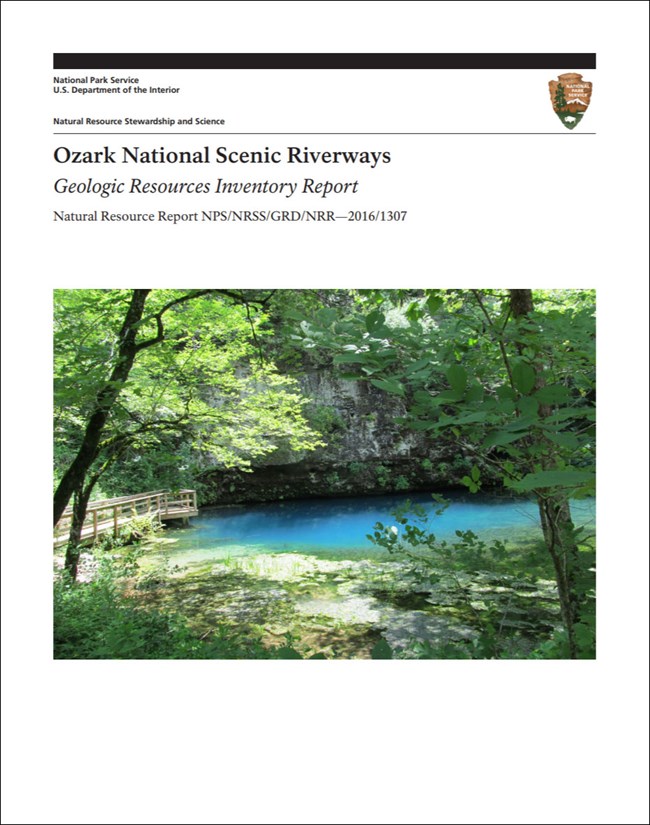Last updated: July 11, 2024
Article
NPS Geodiversity Atlas—Ozark National Scenic Riverways, Missouri
Geodiversity refers to the full variety of natural geologic (rocks, minerals, sediments, fossils, landforms, and physical processes) and soil resources and processes that occur in the park. A product of the Geologic Resources Inventory, the NPS Geodiversity Atlas delivers information in support of education, Geoconservation, and integrated management of living (biotic) and non-living (abiotic) components of the ecosystem.

Introduction
Ozark National Scenic Riverways (OZAR) includes portions of the Current River and Jacks Fork River, protecting a 216-km (134-mi) stretch of clear, free-flowing, spring-fed waterways in Carter, Dent, Shannon, and Texas Counties, Missouri. Authorized on August 27, 1964, OZAR encompasses approximately 30,693 hectares (80,785 acres) and preserves the unique scenic and natural settings associated with the Current and Jacks Fork Rivers, including an impressive number of karst features such as springs, sinkholes, and caves (National Park Service 2016a, 2016d). More than 425 springs are found in OZAR, including the largest spring in the NPS, and the karst system contains more than 400 documented caves. The ancient Ozark Highlands setting of OZAR is home to a diverse ecosystem that hosts a rich array of aquatic, terrestrial, and subterranean habitats containing numerous endemic species found nowhere else on earth. Cultural resources preserved within OZAR include prehistoric sites and 19th century historic structures that record a history of human occupation in the Ozark Highlands spanning thousands of years (National Park Service 2016d).
Geologic Setting
Ozark National Scenic Riverways is part of a dissected karst plain on the Salem Plateau within the Ozark Plateaus physiographic province. The Current River, Jacks Fork River, and their tributaries have slowly cut through layers of bedrock, exposing Paleozoic sedimentary strata punctuated by knobs of older, Precambrian igneous rock that create a landscape featuring picturesque low mountains, rolling hills, hollows, and bluff-flanked valleys (Thornberry-Ehrlich 2016). The oldest rocks in OZAR are ancient Mesoproterozoic-age rhyolite and ash-flow tuff units that underlie the central portion of the scenic riverways near Coot Mountain, Shut-in Mountain, and Russell Mountain. Paleozoic rocks within OZAR span from the Cambrian though the Ordovician and include soluble carbonate rocks that form the steep-sided valleys, springs, and karst landscape that define the scenic riverways and Salem Plateau region. Much younger unconsolidated surficial deposits in OZAR include Quaternary terrace deposits and Holocene alluvium that occur along the course of the rivers and their tributaries.
Regional Geology
Ozark National Scenic Riverways is a part of the Ouachita and Ozark Plateaus Physiographic Province and shares its geologic history and some characteristic geologic formations with a region that extends well beyond park boundaries.
- Scoping summaries are records of scoping meetings where NPS staff and local geologists determined the park’s geologic mapping plan and what content should be included in the report.
- Digital geologic maps include files for viewing in GIS software, a guide to using the data, and a document with ancillary map information. Newer products also include data viewable in Google Earth and online map services.
- Reports use the maps to discuss the park’s setting and significance, notable geologic features and processes, geologic resource management issues, and geologic history.
- Posters are a static view of the GIS data in PDF format. Newer posters include aerial imagery or shaded relief and other park information. They are also included with the reports.
- Projects list basic information about the program and all products available for a park.
Source: NPS DataStore Saved Search 3137. To search for additional information, visit the NPS DataStore.
A NPS Soil Resources Inventory project has been completed for Ozark National Scenic Riverways and can be found on the NPS Data Store.
Source: NPS DataStore Saved Search 3088. To search for additional information, visit the NPS DataStore.

Related Links
Related Articles
Ozark National Scenic Riverways
National Park Service Geodiversity Atlas
The servicewide Geodiversity Atlas provides information on geoheritage and geodiversity resources and values within the National Park System. This information supports science-based geoconservation and interpretation in the NPS, as well as STEM education in schools, museums, and field camps. The NPS Geologic Resources Division and many parks work with National and International geoconservation communities to ensure that NPS abiotic resources are managed using the highest standards and best practices available.

